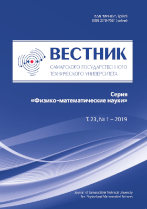|
This article is cited in 5 scientific papers (total in 5 papers)
Mechanics of Solids
The coupled non-stationary thermo-electro-elasticity problem for a long hollow cylinder
D. A. Shlyakhin, M. A. Kal'mova
Samara State Technical University, Samara, 443100, Russian Federation
(published under the terms of the Creative Commons Attribution 4.0 International License)
Abstract:
A new closed solution of the coupled non-stationary thermo-electro-elasticity problem for a long piezoelectric ceramic radially polarized cylinder is constructed while satisfying the boundary conditions of thermal conductivity of the 1st and 3rd kind on its front surfaces.
The case when the rate of change of the temperature field does not affect the inertia characteristics of the elastic system is considered.
This makes it possible to include linear equations of equilibrium, electrostatics, and thermal conductivity with respect to the radial component of the displacement vector, electric potential, and also the function of changing the temperature field in the initial calculated relations of the problem under consideration.
In the calculations, the classical Fourier law of thermal conductivity is used.
To solve the problem, the mathematical apparatus of incomplete separation of variables is used in the form of a generalized biorthogonal finite integral transformation based on the multicomponent relation of the eigenvector functions of two homogeneous boundary value problems. An important point in the procedure of the structural algorithm of this method is the selection of the adjoint operator, without which it is impossible to solve non-self-adjoint linear problems of mathematical physics.
The constructed calculated relationships make it possible to determine the stress-strain state, temperature and electric fields induced in a piezoelectric ceramic element under an arbitrary temperature external influence. An analysis of the numerical results makes it possible to determine the cylinder wall thickness at which the electric field leads to a redistribution of the temperature field. It is established that the rate of change in the volume of a piezoceramic body under external temperature influence does not significantly affect the temperature field.
The developed calculation algorithm finds its application in the design of non-resonant piezoelectric temperature sensors.
Keywords:
long piezoceramic cylinder, coupled thermo-electro-elasticity problem, unsteady temperature effect, finite integral transformations.
Received: April 13, 2020
Revised: October 19, 2020
Accepted: November 16, 2020
First online: December 17, 2020
Citation:
D. A. Shlyakhin, M. A. Kal'mova, “The coupled non-stationary thermo-electro-elasticity problem for a long hollow cylinder”, Vestn. Samar. Gos. Tekhn. Univ., Ser. Fiz.-Mat. Nauki [J. Samara State Tech. Univ., Ser. Phys. Math. Sci.], 24:4 (2020), 677–691
Linking options:
https://www.mathnet.ru/eng/vsgtu1781 https://www.mathnet.ru/eng/vsgtu/v224/i4/p677
|

| Statistics & downloads: |
| Abstract page: | 368 | | Full-text PDF : | 241 | | References: | 37 |
|




 Contact us:
Contact us: Terms of Use
Terms of Use
 Registration to the website
Registration to the website Logotypes
Logotypes









 Citation in format
Citation in format 
